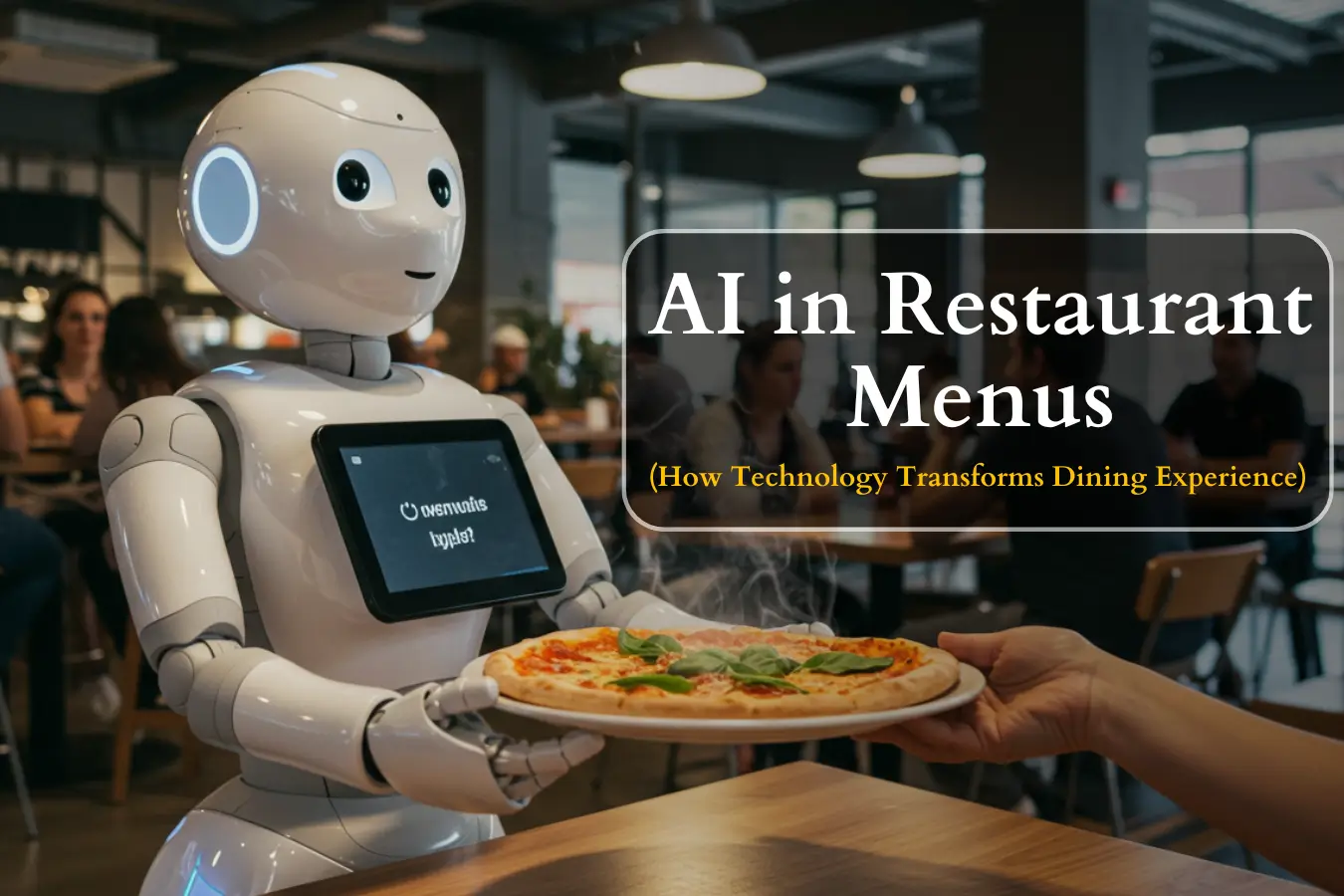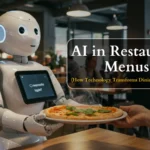Restaurants are always looking for new ways to make dining more enjoyable. Artificial intelligence plays a significant role in advanced technology and menu design. From personalized recommendations to interactive digital menus, AI transforms how people order food and experience dining.
AI in restaurant menus creates personalized experiences by offering suggestions based on customer preferences, past orders, trends, and real-time data. It enhances dining, simplifies ordering, boosts sales, reduces waste, and improves customer service with AI chatbots and voice assistants.
In this article, we’ll explore the role of AI in restaurant menus and how it enhances the dining experience. Whether through automated ordering systems, intelligent recommendations, or interactive digital displays, AI makes eating out more personalized, efficient, and enjoyable.
How Does AI Design Restaurant Menus?
AI is beginning to play a more significant role in refining menu layouts and increasing profitability through data-driven insights, chefs and owners of over 50 restaurants worldwide. We can optimize topline sales and overall profitability by inputting sales metrics and menu design into GPT. He notes that minor modifications, such as relocating high-profit products, can significantly impact. For example, he will suggest new vegan dishes if we order vegan options.

Real-World Examples of AI in Menus
Large food chains like McDonald’s and Domino’s have effectively implemented AI into their menu systems. McDonald’s employs AI-powered kiosks to recommend menu choices depending on the customer’s location, time of day, and past orders. Similarly, Domino’s uses AI to recommend pizza options based on previous customer preferences, making ordering more straightforward and faster.
How Does AI Help with Answering Calls and Managing Reservations?
An AI-powered booking revolution is already well underway in the reservations space. Restaurants are using AI agents, which are essentially (almost) autonomous bots that can carry out tasks synchronously with a human, to handle reservations and respond to phone inquiries regarding menus and opening times. AI assistants can already make appointments independently; the technology will also “learn diners’ tastes and give tailored suggestions.
How Are Restaurants Using AI Technology to Transform Their Menus?
AI in restaurant menus is changing the way restaurants design and update their offerings. AI helps restaurants decide which dishes to highlight, adjust prices, and create new menu items by analyzing customer preferences, sales data, and food trends.
Some restaurants use AI-powered dynamic menus that update in real-time based on weather, time of day, or ingredient availability. For example, on a hot day, the menu might feature more cold beverages and salads.
AI also helps with menu personalization, suggesting dishes based on a customer’s past orders or dietary preferences. This improves the dining experience and boosts customer satisfaction and sales. As technology evolves, AI-driven menus will become even smarter, making dining more convenient and personalized.
How Do Interactive Digital Menus Change the Ordering Process?
Interactive restaurant menus are available on tablets and through QR codes, making the process easier and more convenient. Instead of looking through a paper menu, guests can explore a digital version on their phone or tablet. These menus include clear photographs and full descriptions, allowing diners to customize ingredients, quantities, and toppings to their liking.
One primary benefit of digital menus is the additional information they provide. Customers can browse nutritional information and allergen warnings, and read reviews or recommendations. This allows people to make better decisions based on their dietary requirements and preferences. Furthermore, digital menus speed up the ordering process, lowering wait times and improving service efficiency.
Restaurants can also use interactive menus to change their products in real-time, such as introducing new meals or changing prices, without printing new menus. This technology enhances the dining experience, helps restaurants run more smoothly, and reduces order errors.

How Digital Menus Benefit Restaurants and Customers
Digital menus make ordering easier and more enjoyable for customers. They can see clear pictures of dishes, check ingredients, and even find nutritional details, helping them make better choices. Restaurants save money by reducing the need for printed menus and can update their offerings instantly. These menus also help businesses understand what customers like by tracking popular orders. With this data, restaurants can improve their menus and offer better dining experiences. Digital restaurant menus make eating out more convenient, efficient, and enjoyable.
How AI Helps in Reducing Food Waste
AI-powered analytics are helping restaurants reduce food wastage. By evaluating sales data, AI can optimize our manufacturing schedules to eliminate waste and increase productivity,” explains Vongerichten. AI systems can produce improved production plans based on previous sales patterns, allowing restaurants to prepare precisely enough food to fulfill demand while avoiding extras.
And these tools are becoming more complex. IHG Luxury Properties is testing an AI system that uses smart garbage bin cameras to detect discarded food. According to Gingerich, this technology will provide insights into “cutting waste, boosting profitability, guest satisfaction, and sustainability.
Can AI Predict Food Trends for Restaurants?
AI in restaurant menus can help predict food trends by analyzing customer preferences, social media trends, and current food movements. AI alerts restaurants to which meals may be in high demand shortly. For example, if AI identifies a growing demand for plant-based dishes, a restaurant may expand its vegan menu. This allows businesses to stay ahead of the curve and provide cuisine that customers are passionate about.
How AI Improves Menu Offerings
AI helps restaurants enhance their menus by determining which items are popular and which are not. Restaurants can use this information to change prices and portion sizes and even delete items that are not selling well. This not only keeps customers satisfied but also increases profitability.
How Are Voice Assistants and Chatbots Changing the Ordering Experience?
Technology is making food ordering faster and easier, thanks to voice assistants for restaurants like Amazon Alexa and Google Assistant. Customers can voice their requests instead of calling or placing an order manually, making the process smooth and convenient. This hands-free approach benefits busy people who want to order food quickly without navigating menus or waiting in line. Voice assistants for ordering allow restaurants to streamline the process, reduce wait times, and improve customer satisfaction.
Chatbots for Fast, Efficient Service
Chatbots are also transforming the restaurant experience. Many restaurant technologies now use AI-powered chatbots on their websites, mobile apps, and social media pages to assist customers 24/7. These chatbots can take orders, suggest menu items, answer common questions, and update delivery times.
Customers get instant responses since they’re always available, making the ordering process more efficient and enjoyable. Whether through voice assistants for ordering or AI chatbots, technology is helping voice assistants for restaurants provide a smoother, more personalized dining experience for customers.
What Does the Future Hold for Restaurant Menus?
Restaurant menus are becoming more advanced, and technology is shaping how we order and dine. In the future, menus might be updated in real-time based on the weather, customer preferences, or ingredient availability. Imagine seeing warm soups featured on a chilly day or refreshing drinks on a hot afternoon.
Augmented reality (AR) could also let customers view 3D images of dishes before ordering, making dining more interactive. Meanwhile, AI-powered kitchens may use robots to prepare meals based on real-time data, ensuring efficiency and consistency. These innovations will make restaurant menus more innovative, personalized, and visually engaging.
Conclusion
In conclusion, AI in restaurant menus transforms how restaurants develop and maintain their menus. From personalized recommendations to computerized ordering systems and voice commands, technology is improving the eating experience for customers while also allowing restaurants to operate more efficiently.
As these technologies advance, restaurants will discover new ways to engage customers, expand their menus, and improve service. These innovations offer an exciting future for both diners and restaurant operators.
For More Info About UK Food Menus Must Visit Hot Menus










